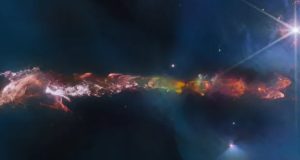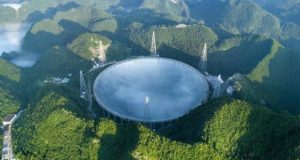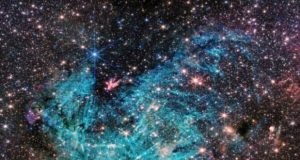
دانشمندان بیسابقهترین جزئیات از تولد بزرگترین ستاره راه شیری در درون یک ابر تیره واقع در فاصله 10 هزار سال نوری از زمین را مشاهده کردند.تیم علمی حاضر در این مطالعه از تلسکوپ آرایه میلیمتری/زیرمیلیمتری بزرگ آتاکاما(ALMA) در شیلی که قدرتمندترین تلسکوپ رادیویی جهان است، بهره بردند.
آنها از این تلسکوپ برای مشاهده یک رحم ستارهای استفاده کردند که 500 برابر خورشید جرم دارد و چندین برابر روشنتر از آن بوده و بزرگترین رحمستارهای در کهکشان راه شیری است.این مشاهدات نشان میدهد که چگونه ماده همگام با تعدادی از رشتهها یا تارهای غلیظ، توسط کشش گرانشی ستاره در حال شکلگیری، به درون مرکز ابر گازی عظیم جذب میشود.این بزرگترین پرتوستارهای است که تاکنون در کهکشان راه شیری مشاهده شده است.انتظار میرود ابر موصوف، دست کم یک ستاره (یا ستارگانی) را شکل دهد که 100 برابر خورشید جرم دارد و بیش از یک میلیون برابر شفافتر از آن است.
از هر 10 هزار ستاره کهکشان راه شیری، فقط یک ستاره به چنین جرمی میرسد.نظریههای فراوانی در خصوص چگونگی شکلگیری ستارههای عظیم وجود دارند اما تیم علمی حاضر در این پروژه بر این باور است که هسته ابر کلی به سمت درون شروع به فرویختن میکند و ماده به سوی مرکز افشانه میشود تا یک یا تعداد بیشتری ستاره عظیم را شکل دهد.
به گفته پروفسور گی فولر از دانشگاه منچستر و محقق حاضر در این مطالعه، این ستارگان نه تنها کمیاب هستند بلکه تولد آنها بینهایت سریع است و بنابراین دوران طفولیت آنها کوتاه است؛ در نتیجه، یافتن چنین شیء عظیمی در بدو تکامل در کهکشان راه شیری دستاورد قابلتوجهی در نوع خود به شمار میآید.
این مشاهدات به طور دقیق جزئیات ریز شبکه رشتهای ابر و گاز را نشان میدهد که به درون ناحیه فشرده ابر جاری میشود و به شدت از نظریه نابودی جهان برای تشکیل ستارگان عظیم پشتیبانی میکند.
جزئیات این کشف علمی در مجله Astronomy and Astrophysics منتشر میشود.
منبع : astronomy
ALMA prenatal scan reveals embryonic monster star
Scientists discovered a protostellar core expected to become a rare brilliant star with up to 100 times the mass of the Sun.
New observations using the Atacama Large Millimeter/submillimeter Array (ALMA) have given astronomers the best view yet of a monster star in the process of forming within a dark cloud. A stellar womb with over 500 times the mass of the Sun has been found — the largest ever seen in the Milky Way — and it is still growing. The embryonic star within the cloud is hungrily feeding on material that is racing inward. The cloud is expected to give birth to a brilliant star with up to 100 times the mass of the Sun.
The most massive and brightest stars in the galaxy form within cool and dark clouds, but the process remains not just shrouded in dust, but also in mystery. An international team of astronomers has now used ALMA to perform a microwave prenatal scan to get a clearer look at the formation of one such monster star that is located around 11,000 light-years away in a cloud known as the Spitzer Dark Cloud (SDC) 335.579-0.292.
There are two theories on the formation of the most massive stars. One suggests that the parental dark cloud fragments, creating several small cores that collapse on their own and eventually form stars. The other is more dramatic: The entire cloud begins to collapse inward, with material racing toward the cloud’s center to form one or more massive behemoths there. A team led by Nicolas Peretto of CEA/AIM Paris-Saclay, France, and Cardiff University, United Kingdom, realized that ALMA was the perfect tool to help find out what was really happening.
SDC 335.579-0.292 was first revealed as a dramatic environment of dark dense filaments of gas and dust through observations with NASA’s Spitzer Space Telescope and the European Space Agency’s (ESA) Herschel Space Observatory. Now the team has used the unique sensitivity of ALMA to look in detail at both the amount of dust and the motion of the gas moving around within the dark cloud — and they have found a true monster.
“The remarkable observations from ALMA allowed us to get the first really in-depth look at what was going on within this cloud,” said Peretto. “We wanted to see how monster stars form and grow, and we certainly achieved our aim. One of the sources we have found is an absolute giant — the largest protostellar core ever spotted in the Milky Way.”
This core — the womb of the embryonic star — has over 500 times the mass of our Sun swirling around within it. And the ALMA observations show that much more material is still flowing inward and increasing the mass still further. This material will eventually collapse to form a young star up to 100 times as massive as our home star — a very rare beast.
“Even though we already believed that the region was a good candidate for being a massive star-forming cloud, we were not expecting to find such a massive embryonic star at its center,” said Peretto. “This object is expected to form a star that is up to 100 times more massive than the Sun. Only about one in 10 thousand of all the stars in the Milky Way reach that kind of mass.”
“Not only are these stars rare, but their birth is extremely rapid and their childhood is short, so finding such a massive object so early in its evolution is a spectacular result,” said Gary Fuller from the University of Manchester, United Kingdom.
“The ALMA observations reveal the spectacular details of the motions of the filamentary network of dust and gas and show that a huge amount of gas is flowing into a central compact region,” said Ana Duarte Cabral from the Laboratory of Astrophysics of Bordeaux, France. “This strongly supports the theory of global collapse for the formation of massive stars, rather than fragmentation.”
These observations formed part of the early science phase of ALMA and have made use of just a quarter of the full array of antennas. “We managed to get these very detailed observations using only a fraction of ALMA’s ultimate potential,” said Peretto. “ALMA will definitely revolutionize our knowledge of star formation, solving some current problems and certainly raising new ones.”
 گجت نیوز آخرین اخبار گجتی و فناوری های روز دنیا
گجت نیوز آخرین اخبار گجتی و فناوری های روز دنیا 





